Risks and Recommendations for Trading.com
VerifiedAdded on 2023/03/20
|11
|2931
|37
AI Summary
This report evaluates the current risks exposure of Trading.com and provides recommendations for addressing those risks. It focuses on risks due to growth, risks due to organizational culture, and information handling risks. The report suggests measures to reduce risks and improve the company's operations.
Contribute Materials
Your contribution can guide someone’s learning journey. Share your
documents today.
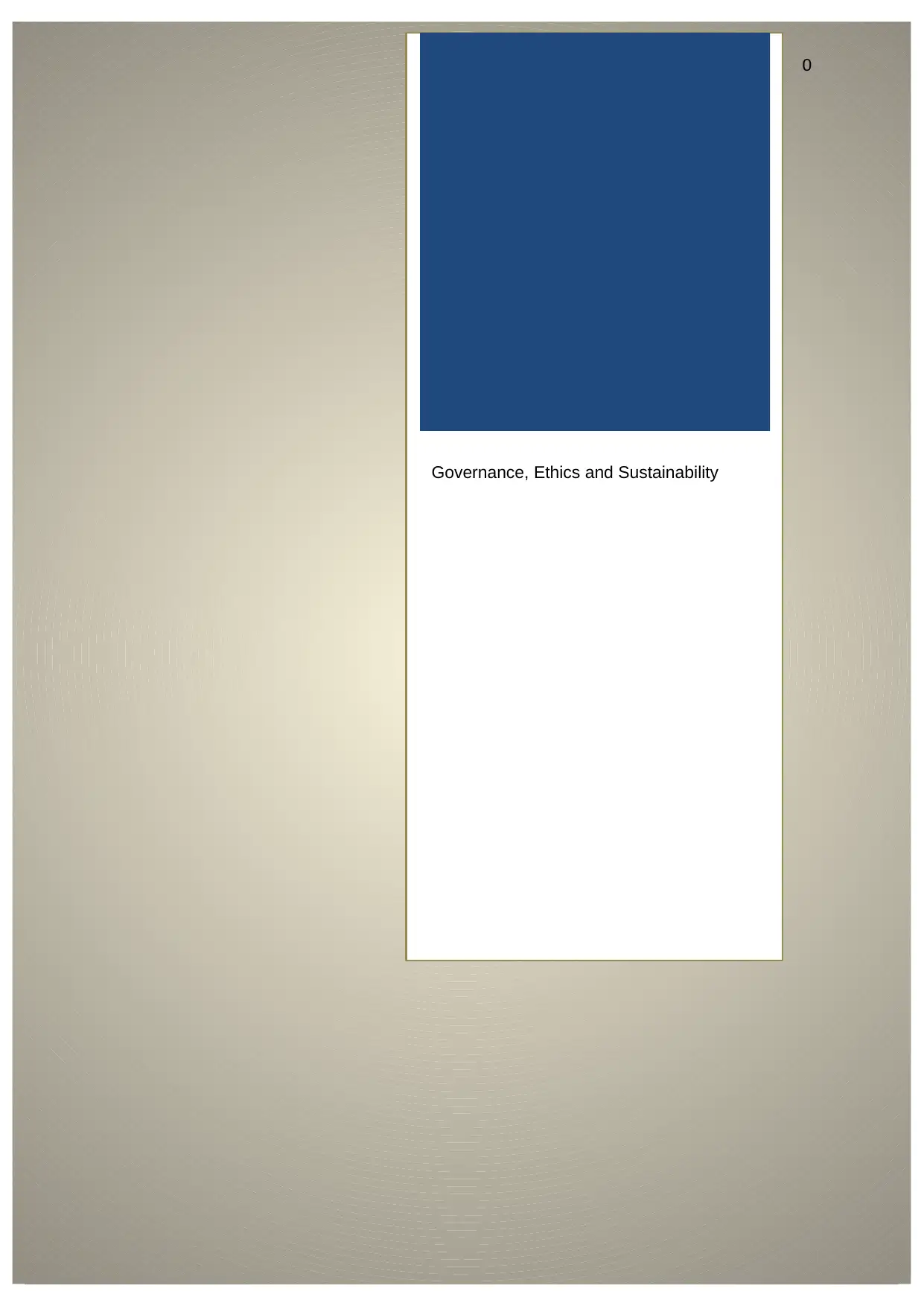
0
Governance, Ethics and Sustainability
Governance, Ethics and Sustainability
Secure Best Marks with AI Grader
Need help grading? Try our AI Grader for instant feedback on your assignments.
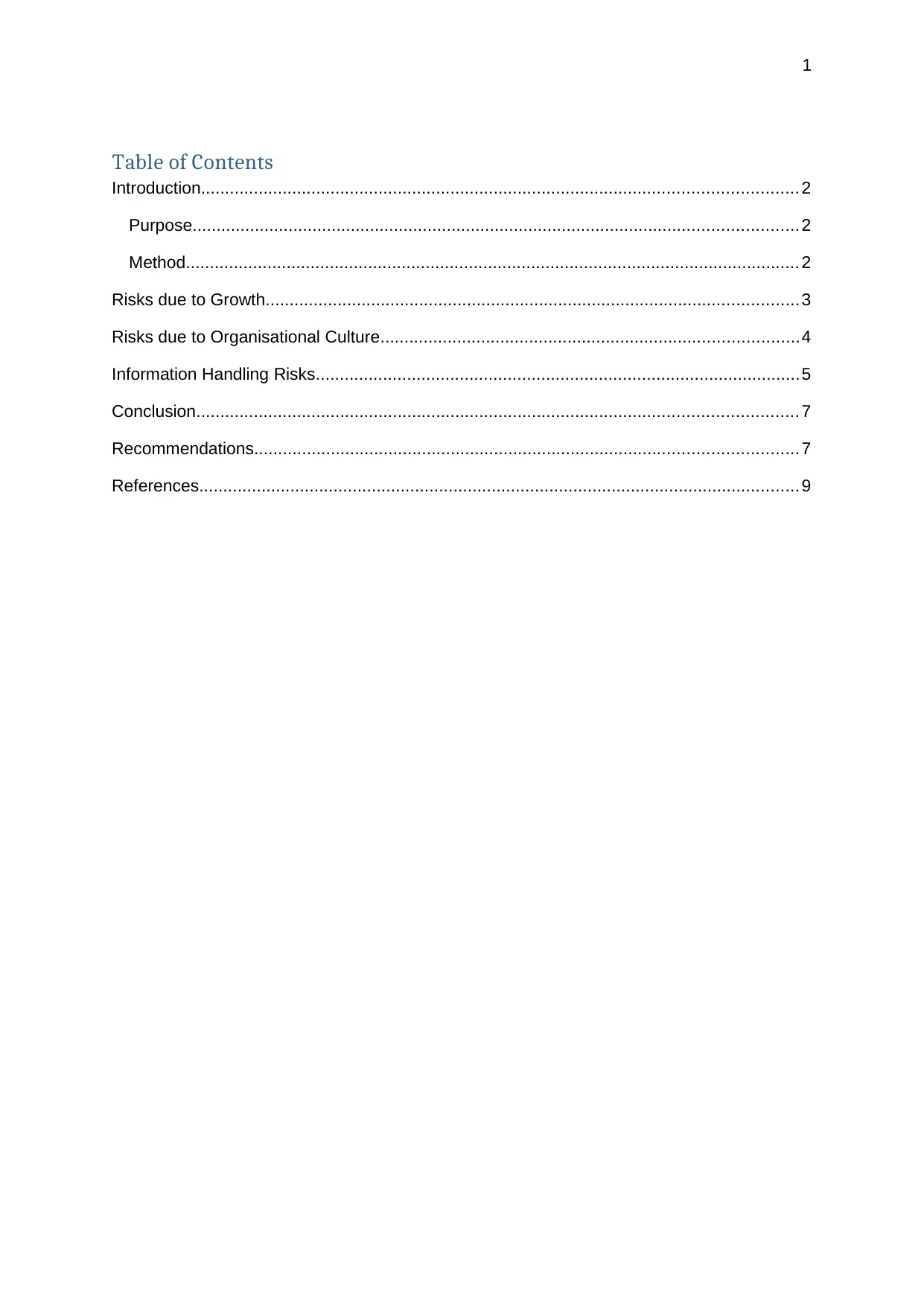
1
Table of Contents
Introduction............................................................................................................................ 2
Purpose.............................................................................................................................. 2
Method................................................................................................................................ 2
Risks due to Growth...............................................................................................................3
Risks due to Organisational Culture.......................................................................................4
Information Handling Risks.....................................................................................................5
Conclusion............................................................................................................................. 7
Recommendations................................................................................................................. 7
References............................................................................................................................. 9
Table of Contents
Introduction............................................................................................................................ 2
Purpose.............................................................................................................................. 2
Method................................................................................................................................ 2
Risks due to Growth...............................................................................................................3
Risks due to Organisational Culture.......................................................................................4
Information Handling Risks.....................................................................................................5
Conclusion............................................................................................................................. 7
Recommendations................................................................................................................. 7
References............................................................................................................................. 9
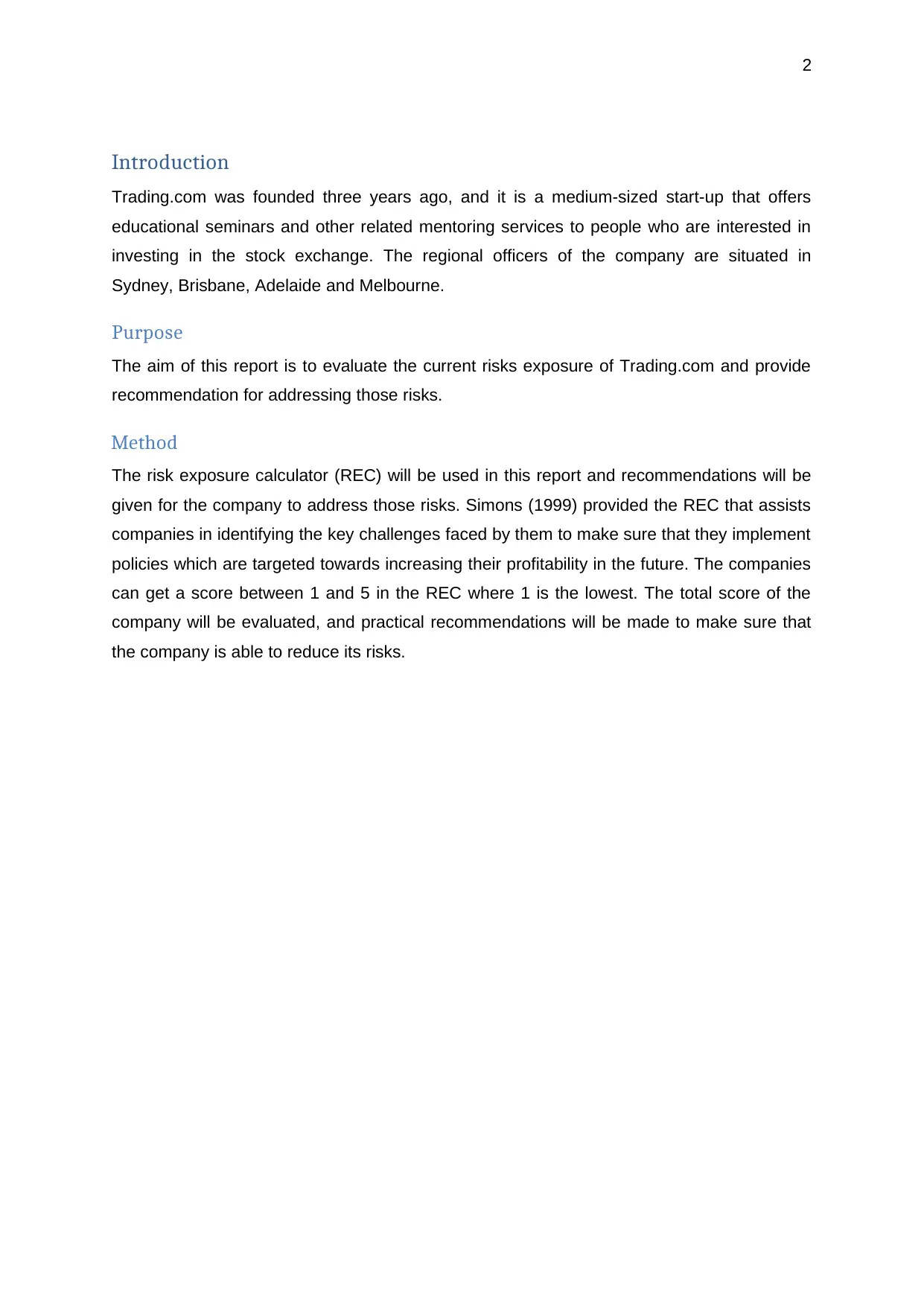
2
Introduction
Trading.com was founded three years ago, and it is a medium-sized start-up that offers
educational seminars and other related mentoring services to people who are interested in
investing in the stock exchange. The regional officers of the company are situated in
Sydney, Brisbane, Adelaide and Melbourne.
Purpose
The aim of this report is to evaluate the current risks exposure of Trading.com and provide
recommendation for addressing those risks.
Method
The risk exposure calculator (REC) will be used in this report and recommendations will be
given for the company to address those risks. Simons (1999) provided the REC that assists
companies in identifying the key challenges faced by them to make sure that they implement
policies which are targeted towards increasing their profitability in the future. The companies
can get a score between 1 and 5 in the REC where 1 is the lowest. The total score of the
company will be evaluated, and practical recommendations will be made to make sure that
the company is able to reduce its risks.
Introduction
Trading.com was founded three years ago, and it is a medium-sized start-up that offers
educational seminars and other related mentoring services to people who are interested in
investing in the stock exchange. The regional officers of the company are situated in
Sydney, Brisbane, Adelaide and Melbourne.
Purpose
The aim of this report is to evaluate the current risks exposure of Trading.com and provide
recommendation for addressing those risks.
Method
The risk exposure calculator (REC) will be used in this report and recommendations will be
given for the company to address those risks. Simons (1999) provided the REC that assists
companies in identifying the key challenges faced by them to make sure that they implement
policies which are targeted towards increasing their profitability in the future. The companies
can get a score between 1 and 5 in the REC where 1 is the lowest. The total score of the
company will be evaluated, and practical recommendations will be made to make sure that
the company is able to reduce its risks.
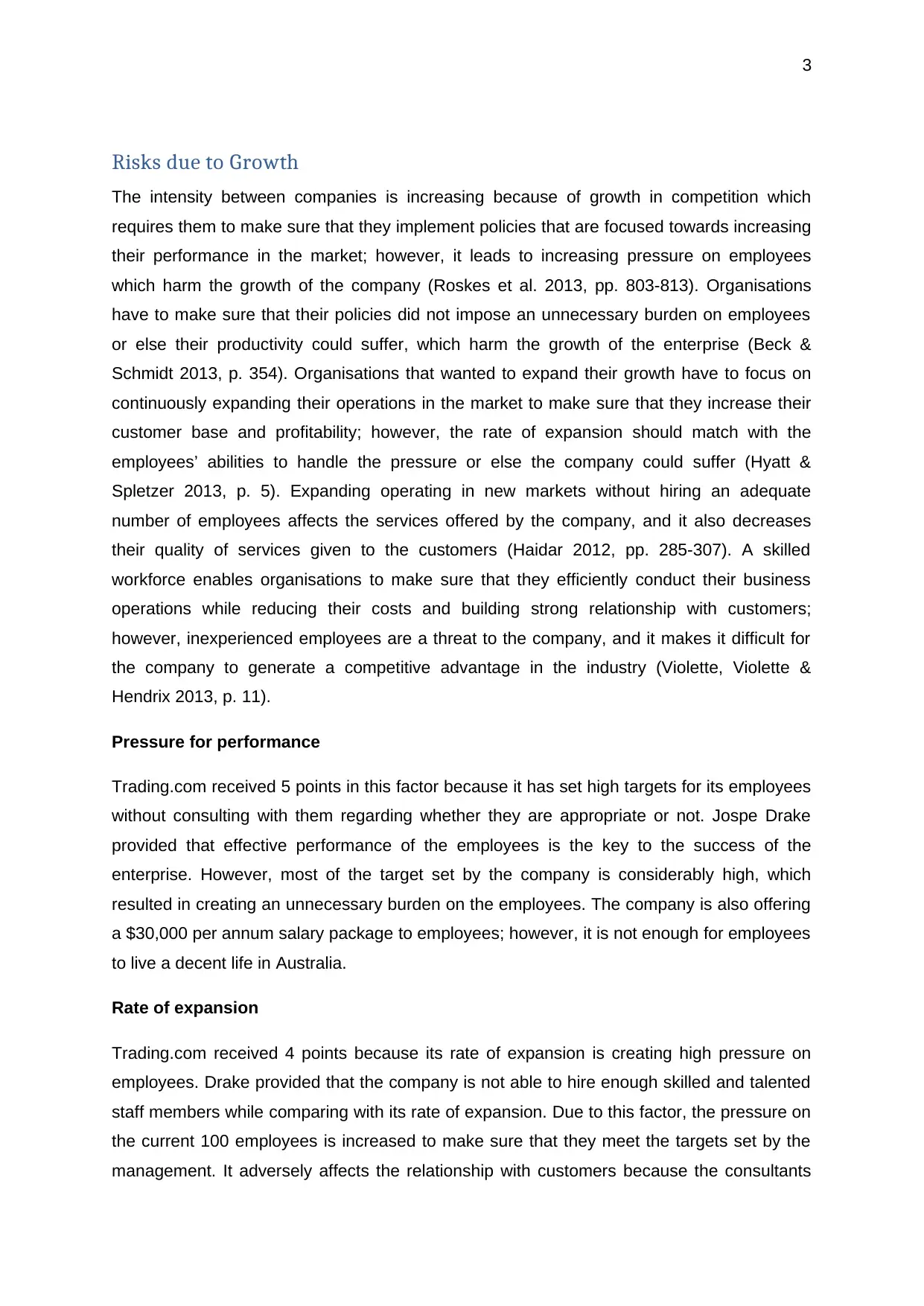
3
Risks due to Growth
The intensity between companies is increasing because of growth in competition which
requires them to make sure that they implement policies that are focused towards increasing
their performance in the market; however, it leads to increasing pressure on employees
which harm the growth of the company (Roskes et al. 2013, pp. 803-813). Organisations
have to make sure that their policies did not impose an unnecessary burden on employees
or else their productivity could suffer, which harm the growth of the enterprise (Beck &
Schmidt 2013, p. 354). Organisations that wanted to expand their growth have to focus on
continuously expanding their operations in the market to make sure that they increase their
customer base and profitability; however, the rate of expansion should match with the
employees’ abilities to handle the pressure or else the company could suffer (Hyatt &
Spletzer 2013, p. 5). Expanding operating in new markets without hiring an adequate
number of employees affects the services offered by the company, and it also decreases
their quality of services given to the customers (Haidar 2012, pp. 285-307). A skilled
workforce enables organisations to make sure that they efficiently conduct their business
operations while reducing their costs and building strong relationship with customers;
however, inexperienced employees are a threat to the company, and it makes it difficult for
the company to generate a competitive advantage in the industry (Violette, Violette &
Hendrix 2013, p. 11).
Pressure for performance
Trading.com received 5 points in this factor because it has set high targets for its employees
without consulting with them regarding whether they are appropriate or not. Jospe Drake
provided that effective performance of the employees is the key to the success of the
enterprise. However, most of the target set by the company is considerably high, which
resulted in creating an unnecessary burden on the employees. The company is also offering
a $30,000 per annum salary package to employees; however, it is not enough for employees
to live a decent life in Australia.
Rate of expansion
Trading.com received 4 points because its rate of expansion is creating high pressure on
employees. Drake provided that the company is not able to hire enough skilled and talented
staff members while comparing with its rate of expansion. Due to this factor, the pressure on
the current 100 employees is increased to make sure that they meet the targets set by the
management. It adversely affects the relationship with customers because the consultants
Risks due to Growth
The intensity between companies is increasing because of growth in competition which
requires them to make sure that they implement policies that are focused towards increasing
their performance in the market; however, it leads to increasing pressure on employees
which harm the growth of the company (Roskes et al. 2013, pp. 803-813). Organisations
have to make sure that their policies did not impose an unnecessary burden on employees
or else their productivity could suffer, which harm the growth of the enterprise (Beck &
Schmidt 2013, p. 354). Organisations that wanted to expand their growth have to focus on
continuously expanding their operations in the market to make sure that they increase their
customer base and profitability; however, the rate of expansion should match with the
employees’ abilities to handle the pressure or else the company could suffer (Hyatt &
Spletzer 2013, p. 5). Expanding operating in new markets without hiring an adequate
number of employees affects the services offered by the company, and it also decreases
their quality of services given to the customers (Haidar 2012, pp. 285-307). A skilled
workforce enables organisations to make sure that they efficiently conduct their business
operations while reducing their costs and building strong relationship with customers;
however, inexperienced employees are a threat to the company, and it makes it difficult for
the company to generate a competitive advantage in the industry (Violette, Violette &
Hendrix 2013, p. 11).
Pressure for performance
Trading.com received 5 points in this factor because it has set high targets for its employees
without consulting with them regarding whether they are appropriate or not. Jospe Drake
provided that effective performance of the employees is the key to the success of the
enterprise. However, most of the target set by the company is considerably high, which
resulted in creating an unnecessary burden on the employees. The company is also offering
a $30,000 per annum salary package to employees; however, it is not enough for employees
to live a decent life in Australia.
Rate of expansion
Trading.com received 4 points because its rate of expansion is creating high pressure on
employees. Drake provided that the company is not able to hire enough skilled and talented
staff members while comparing with its rate of expansion. Due to this factor, the pressure on
the current 100 employees is increased to make sure that they meet the targets set by the
management. It adversely affects the relationship with customers because the consultants
Secure Best Marks with AI Grader
Need help grading? Try our AI Grader for instant feedback on your assignments.
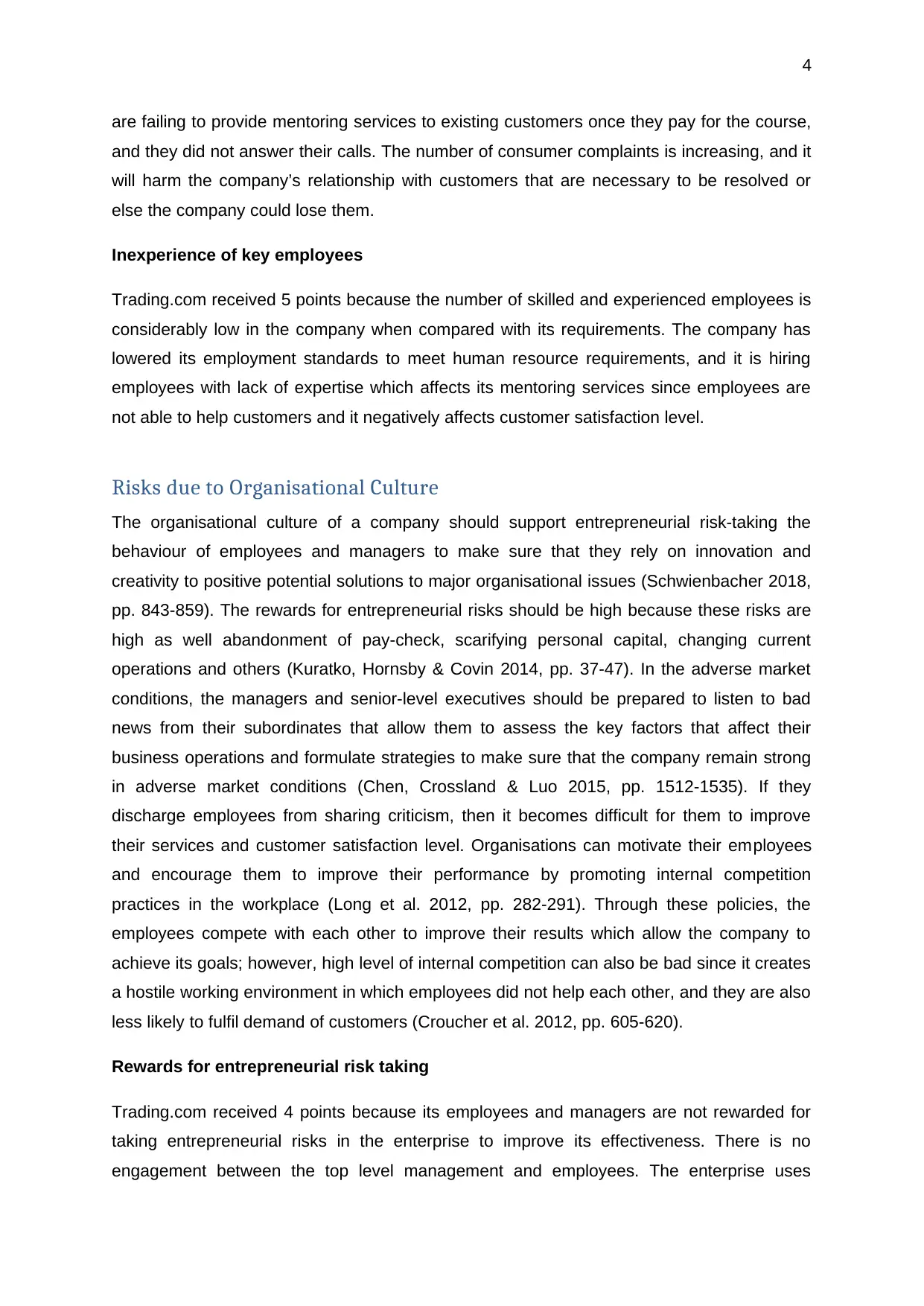
4
are failing to provide mentoring services to existing customers once they pay for the course,
and they did not answer their calls. The number of consumer complaints is increasing, and it
will harm the company’s relationship with customers that are necessary to be resolved or
else the company could lose them.
Inexperience of key employees
Trading.com received 5 points because the number of skilled and experienced employees is
considerably low in the company when compared with its requirements. The company has
lowered its employment standards to meet human resource requirements, and it is hiring
employees with lack of expertise which affects its mentoring services since employees are
not able to help customers and it negatively affects customer satisfaction level.
Risks due to Organisational Culture
The organisational culture of a company should support entrepreneurial risk-taking the
behaviour of employees and managers to make sure that they rely on innovation and
creativity to positive potential solutions to major organisational issues (Schwienbacher 2018,
pp. 843-859). The rewards for entrepreneurial risks should be high because these risks are
high as well abandonment of pay-check, scarifying personal capital, changing current
operations and others (Kuratko, Hornsby & Covin 2014, pp. 37-47). In the adverse market
conditions, the managers and senior-level executives should be prepared to listen to bad
news from their subordinates that allow them to assess the key factors that affect their
business operations and formulate strategies to make sure that the company remain strong
in adverse market conditions (Chen, Crossland & Luo 2015, pp. 1512-1535). If they
discharge employees from sharing criticism, then it becomes difficult for them to improve
their services and customer satisfaction level. Organisations can motivate their employees
and encourage them to improve their performance by promoting internal competition
practices in the workplace (Long et al. 2012, pp. 282-291). Through these policies, the
employees compete with each other to improve their results which allow the company to
achieve its goals; however, high level of internal competition can also be bad since it creates
a hostile working environment in which employees did not help each other, and they are also
less likely to fulfil demand of customers (Croucher et al. 2012, pp. 605-620).
Rewards for entrepreneurial risk taking
Trading.com received 4 points because its employees and managers are not rewarded for
taking entrepreneurial risks in the enterprise to improve its effectiveness. There is no
engagement between the top level management and employees. The enterprise uses
are failing to provide mentoring services to existing customers once they pay for the course,
and they did not answer their calls. The number of consumer complaints is increasing, and it
will harm the company’s relationship with customers that are necessary to be resolved or
else the company could lose them.
Inexperience of key employees
Trading.com received 5 points because the number of skilled and experienced employees is
considerably low in the company when compared with its requirements. The company has
lowered its employment standards to meet human resource requirements, and it is hiring
employees with lack of expertise which affects its mentoring services since employees are
not able to help customers and it negatively affects customer satisfaction level.
Risks due to Organisational Culture
The organisational culture of a company should support entrepreneurial risk-taking the
behaviour of employees and managers to make sure that they rely on innovation and
creativity to positive potential solutions to major organisational issues (Schwienbacher 2018,
pp. 843-859). The rewards for entrepreneurial risks should be high because these risks are
high as well abandonment of pay-check, scarifying personal capital, changing current
operations and others (Kuratko, Hornsby & Covin 2014, pp. 37-47). In the adverse market
conditions, the managers and senior-level executives should be prepared to listen to bad
news from their subordinates that allow them to assess the key factors that affect their
business operations and formulate strategies to make sure that the company remain strong
in adverse market conditions (Chen, Crossland & Luo 2015, pp. 1512-1535). If they
discharge employees from sharing criticism, then it becomes difficult for them to improve
their services and customer satisfaction level. Organisations can motivate their employees
and encourage them to improve their performance by promoting internal competition
practices in the workplace (Long et al. 2012, pp. 282-291). Through these policies, the
employees compete with each other to improve their results which allow the company to
achieve its goals; however, high level of internal competition can also be bad since it creates
a hostile working environment in which employees did not help each other, and they are also
less likely to fulfil demand of customers (Croucher et al. 2012, pp. 605-620).
Rewards for entrepreneurial risk taking
Trading.com received 4 points because its employees and managers are not rewarded for
taking entrepreneurial risks in the enterprise to improve its effectiveness. There is no
engagement between the top level management and employees. The enterprise uses
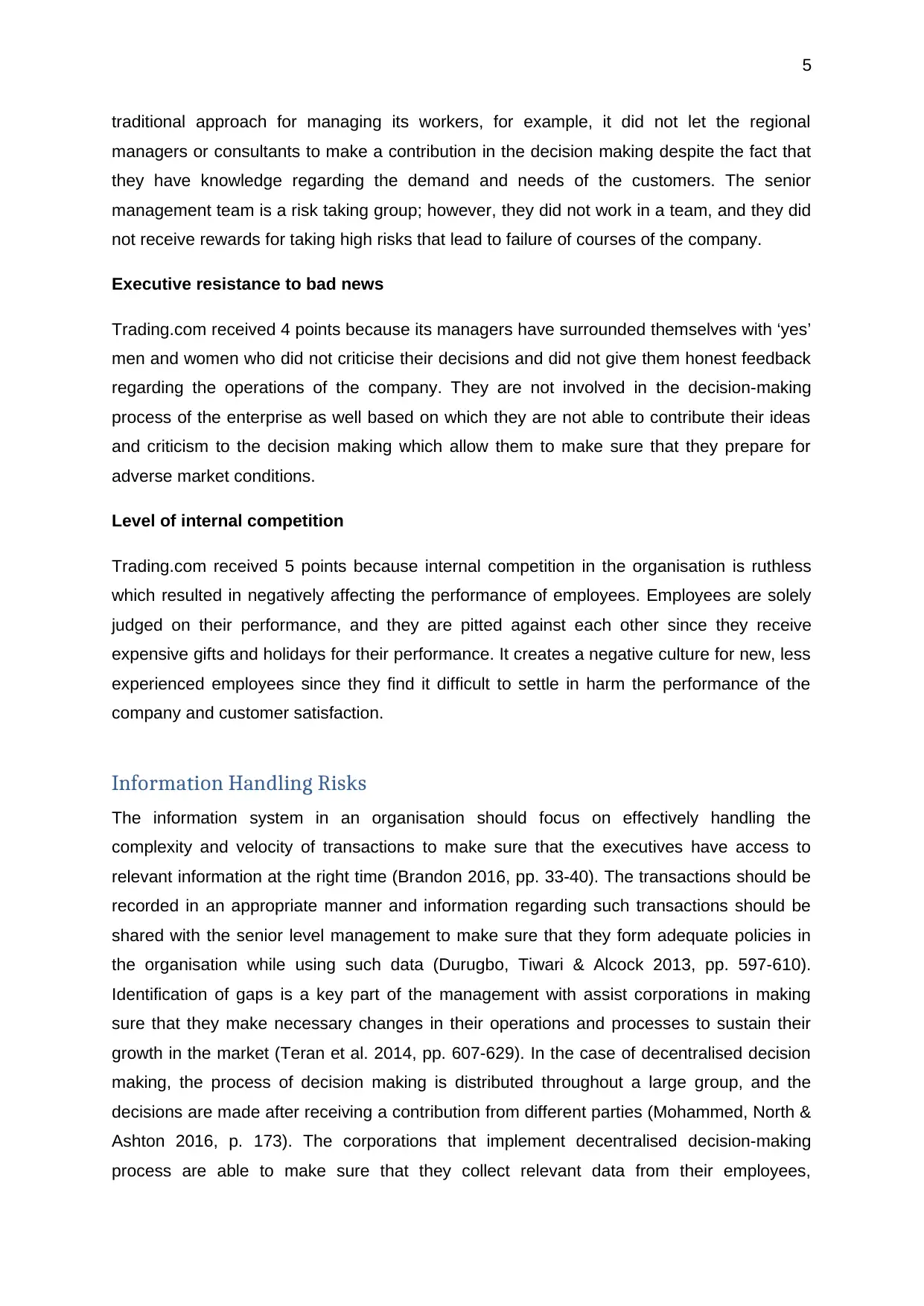
5
traditional approach for managing its workers, for example, it did not let the regional
managers or consultants to make a contribution in the decision making despite the fact that
they have knowledge regarding the demand and needs of the customers. The senior
management team is a risk taking group; however, they did not work in a team, and they did
not receive rewards for taking high risks that lead to failure of courses of the company.
Executive resistance to bad news
Trading.com received 4 points because its managers have surrounded themselves with ‘yes’
men and women who did not criticise their decisions and did not give them honest feedback
regarding the operations of the company. They are not involved in the decision-making
process of the enterprise as well based on which they are not able to contribute their ideas
and criticism to the decision making which allow them to make sure that they prepare for
adverse market conditions.
Level of internal competition
Trading.com received 5 points because internal competition in the organisation is ruthless
which resulted in negatively affecting the performance of employees. Employees are solely
judged on their performance, and they are pitted against each other since they receive
expensive gifts and holidays for their performance. It creates a negative culture for new, less
experienced employees since they find it difficult to settle in harm the performance of the
company and customer satisfaction.
Information Handling Risks
The information system in an organisation should focus on effectively handling the
complexity and velocity of transactions to make sure that the executives have access to
relevant information at the right time (Brandon 2016, pp. 33-40). The transactions should be
recorded in an appropriate manner and information regarding such transactions should be
shared with the senior level management to make sure that they form adequate policies in
the organisation while using such data (Durugbo, Tiwari & Alcock 2013, pp. 597-610).
Identification of gaps is a key part of the management with assist corporations in making
sure that they make necessary changes in their operations and processes to sustain their
growth in the market (Teran et al. 2014, pp. 607-629). In the case of decentralised decision
making, the process of decision making is distributed throughout a large group, and the
decisions are made after receiving a contribution from different parties (Mohammed, North &
Ashton 2016, p. 173). The corporations that implement decentralised decision-making
process are able to make sure that they collect relevant data from their employees,
traditional approach for managing its workers, for example, it did not let the regional
managers or consultants to make a contribution in the decision making despite the fact that
they have knowledge regarding the demand and needs of the customers. The senior
management team is a risk taking group; however, they did not work in a team, and they did
not receive rewards for taking high risks that lead to failure of courses of the company.
Executive resistance to bad news
Trading.com received 4 points because its managers have surrounded themselves with ‘yes’
men and women who did not criticise their decisions and did not give them honest feedback
regarding the operations of the company. They are not involved in the decision-making
process of the enterprise as well based on which they are not able to contribute their ideas
and criticism to the decision making which allow them to make sure that they prepare for
adverse market conditions.
Level of internal competition
Trading.com received 5 points because internal competition in the organisation is ruthless
which resulted in negatively affecting the performance of employees. Employees are solely
judged on their performance, and they are pitted against each other since they receive
expensive gifts and holidays for their performance. It creates a negative culture for new, less
experienced employees since they find it difficult to settle in harm the performance of the
company and customer satisfaction.
Information Handling Risks
The information system in an organisation should focus on effectively handling the
complexity and velocity of transactions to make sure that the executives have access to
relevant information at the right time (Brandon 2016, pp. 33-40). The transactions should be
recorded in an appropriate manner and information regarding such transactions should be
shared with the senior level management to make sure that they form adequate policies in
the organisation while using such data (Durugbo, Tiwari & Alcock 2013, pp. 597-610).
Identification of gaps is a key part of the management with assist corporations in making
sure that they make necessary changes in their operations and processes to sustain their
growth in the market (Teran et al. 2014, pp. 607-629). In the case of decentralised decision
making, the process of decision making is distributed throughout a large group, and the
decisions are made after receiving a contribution from different parties (Mohammed, North &
Ashton 2016, p. 173). The corporations that implement decentralised decision-making
process are able to make sure that they collect relevant data from their employees,
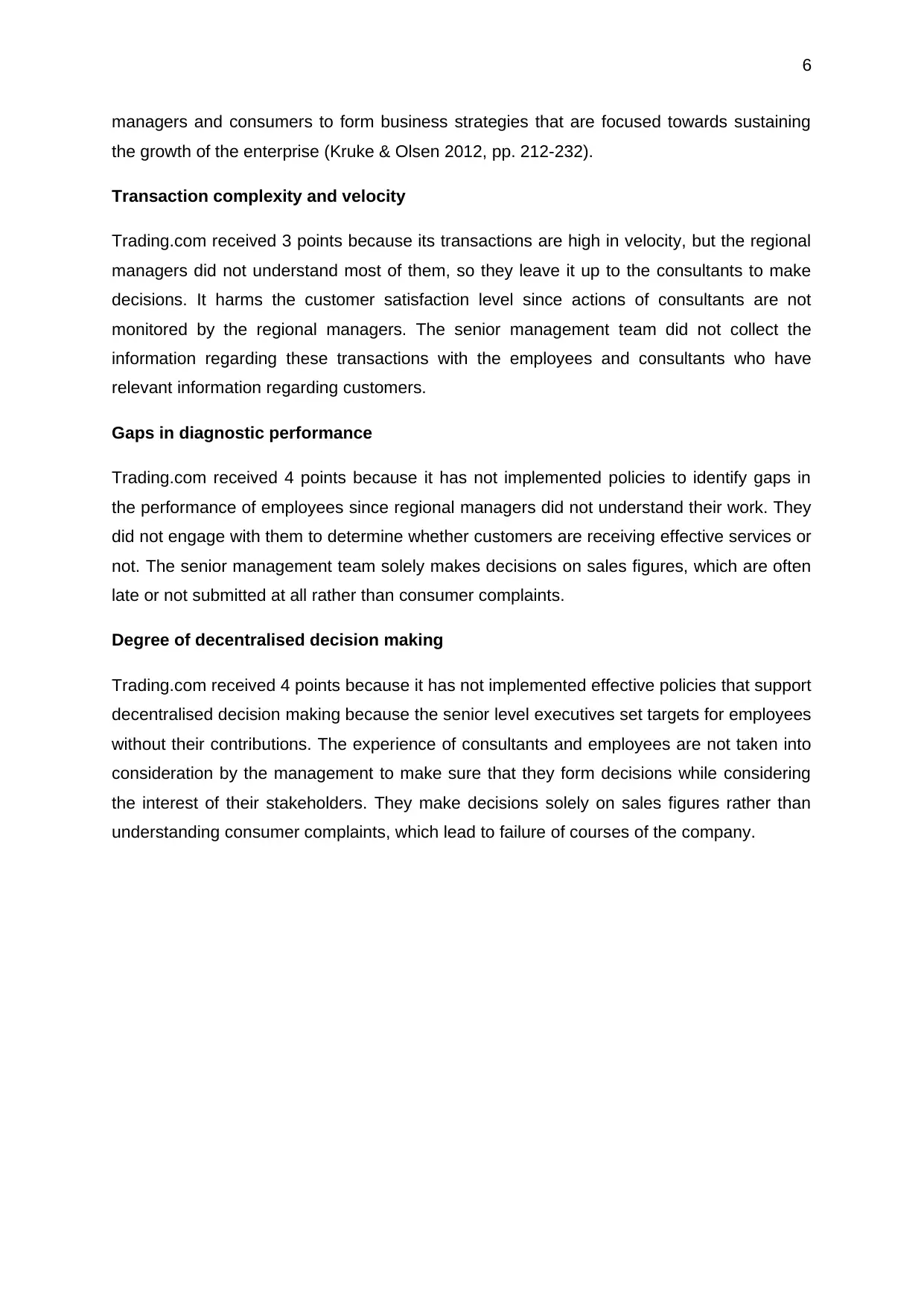
6
managers and consumers to form business strategies that are focused towards sustaining
the growth of the enterprise (Kruke & Olsen 2012, pp. 212-232).
Transaction complexity and velocity
Trading.com received 3 points because its transactions are high in velocity, but the regional
managers did not understand most of them, so they leave it up to the consultants to make
decisions. It harms the customer satisfaction level since actions of consultants are not
monitored by the regional managers. The senior management team did not collect the
information regarding these transactions with the employees and consultants who have
relevant information regarding customers.
Gaps in diagnostic performance
Trading.com received 4 points because it has not implemented policies to identify gaps in
the performance of employees since regional managers did not understand their work. They
did not engage with them to determine whether customers are receiving effective services or
not. The senior management team solely makes decisions on sales figures, which are often
late or not submitted at all rather than consumer complaints.
Degree of decentralised decision making
Trading.com received 4 points because it has not implemented effective policies that support
decentralised decision making because the senior level executives set targets for employees
without their contributions. The experience of consultants and employees are not taken into
consideration by the management to make sure that they form decisions while considering
the interest of their stakeholders. They make decisions solely on sales figures rather than
understanding consumer complaints, which lead to failure of courses of the company.
managers and consumers to form business strategies that are focused towards sustaining
the growth of the enterprise (Kruke & Olsen 2012, pp. 212-232).
Transaction complexity and velocity
Trading.com received 3 points because its transactions are high in velocity, but the regional
managers did not understand most of them, so they leave it up to the consultants to make
decisions. It harms the customer satisfaction level since actions of consultants are not
monitored by the regional managers. The senior management team did not collect the
information regarding these transactions with the employees and consultants who have
relevant information regarding customers.
Gaps in diagnostic performance
Trading.com received 4 points because it has not implemented policies to identify gaps in
the performance of employees since regional managers did not understand their work. They
did not engage with them to determine whether customers are receiving effective services or
not. The senior management team solely makes decisions on sales figures, which are often
late or not submitted at all rather than consumer complaints.
Degree of decentralised decision making
Trading.com received 4 points because it has not implemented effective policies that support
decentralised decision making because the senior level executives set targets for employees
without their contributions. The experience of consultants and employees are not taken into
consideration by the management to make sure that they form decisions while considering
the interest of their stakeholders. They make decisions solely on sales figures rather than
understanding consumer complaints, which lead to failure of courses of the company.
Paraphrase This Document
Need a fresh take? Get an instant paraphrase of this document with our AI Paraphraser

7
Conclusion
Figure 1: Risk Exposure Calculator
(Source: By author)
In conclusion, the companies that score between 9 and 20 on REC are considered as safe.
A score between 21 and 34 shows that the company is in a caution zone where it should
make changes to address its challenges. A score above 35 is considered as a danger zone
for companies, and they have to quickly implement policies to make sure that they reduce
their challenges. Based on the above observations, Trading.com received a score of 38,
which shows that the enterprise is operating in the danger zone as per REC. It is important
that the organisation focus on implementing policies which are targeted towards addressing
the key risks faced by the enterprise to sustain its growth in the market. The company has to
make changes regarding the organisational culture, information system management and
pressure in the workplace to make sure that it improves its operations by reducing its risks.
Recommendations
Trading.com should comply with following suggestions that will assist the enterprise in
addressing the key challenges which it faces, and it will enable the company to eliminate its
risks. The company should slow down its business expansion strategy to reduce the burden
Conclusion
Figure 1: Risk Exposure Calculator
(Source: By author)
In conclusion, the companies that score between 9 and 20 on REC are considered as safe.
A score between 21 and 34 shows that the company is in a caution zone where it should
make changes to address its challenges. A score above 35 is considered as a danger zone
for companies, and they have to quickly implement policies to make sure that they reduce
their challenges. Based on the above observations, Trading.com received a score of 38,
which shows that the enterprise is operating in the danger zone as per REC. It is important
that the organisation focus on implementing policies which are targeted towards addressing
the key risks faced by the enterprise to sustain its growth in the market. The company has to
make changes regarding the organisational culture, information system management and
pressure in the workplace to make sure that it improves its operations by reducing its risks.
Recommendations
Trading.com should comply with following suggestions that will assist the enterprise in
addressing the key challenges which it faces, and it will enable the company to eliminate its
risks. The company should slow down its business expansion strategy to reduce the burden
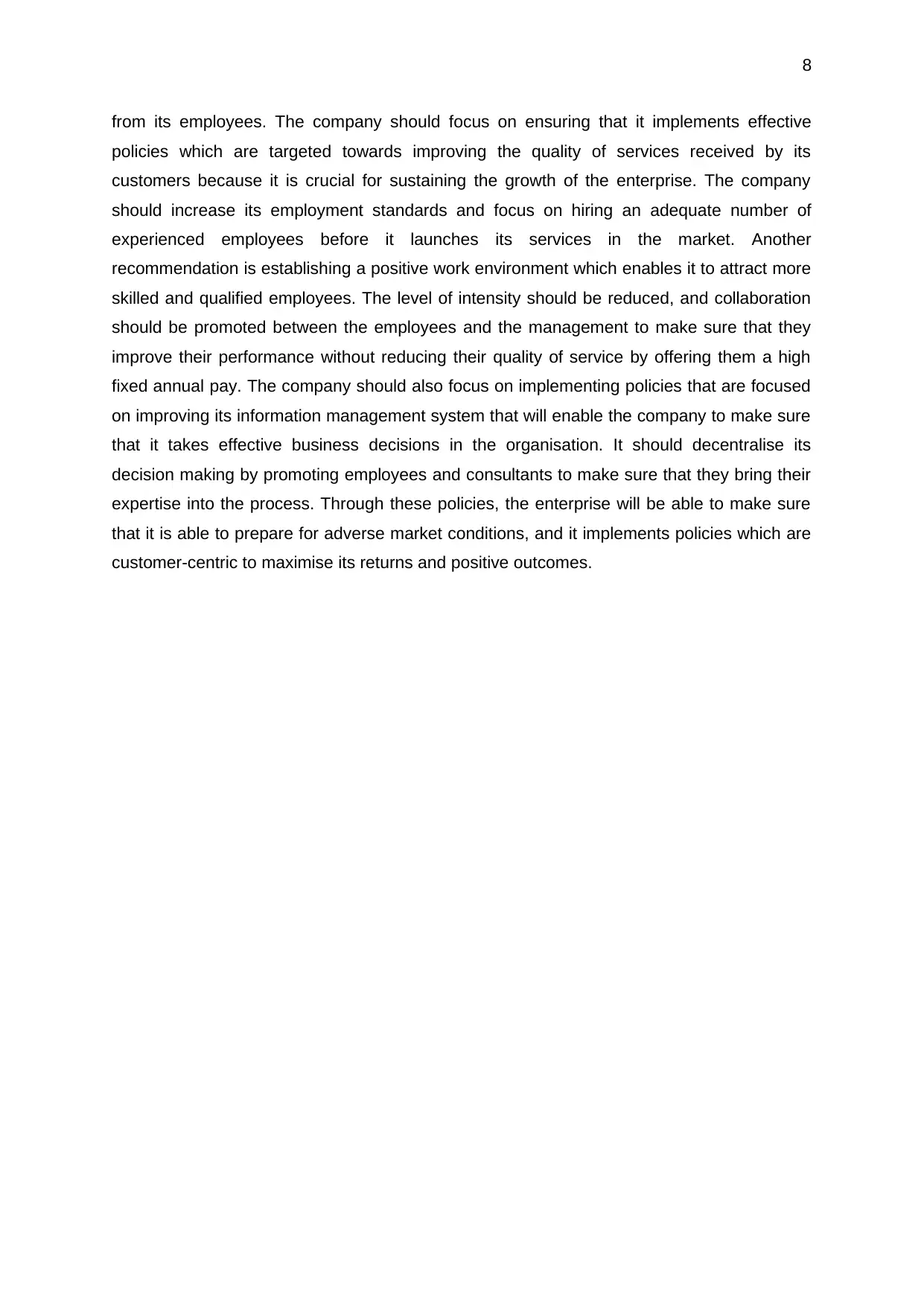
8
from its employees. The company should focus on ensuring that it implements effective
policies which are targeted towards improving the quality of services received by its
customers because it is crucial for sustaining the growth of the enterprise. The company
should increase its employment standards and focus on hiring an adequate number of
experienced employees before it launches its services in the market. Another
recommendation is establishing a positive work environment which enables it to attract more
skilled and qualified employees. The level of intensity should be reduced, and collaboration
should be promoted between the employees and the management to make sure that they
improve their performance without reducing their quality of service by offering them a high
fixed annual pay. The company should also focus on implementing policies that are focused
on improving its information management system that will enable the company to make sure
that it takes effective business decisions in the organisation. It should decentralise its
decision making by promoting employees and consultants to make sure that they bring their
expertise into the process. Through these policies, the enterprise will be able to make sure
that it is able to prepare for adverse market conditions, and it implements policies which are
customer-centric to maximise its returns and positive outcomes.
from its employees. The company should focus on ensuring that it implements effective
policies which are targeted towards improving the quality of services received by its
customers because it is crucial for sustaining the growth of the enterprise. The company
should increase its employment standards and focus on hiring an adequate number of
experienced employees before it launches its services in the market. Another
recommendation is establishing a positive work environment which enables it to attract more
skilled and qualified employees. The level of intensity should be reduced, and collaboration
should be promoted between the employees and the management to make sure that they
improve their performance without reducing their quality of service by offering them a high
fixed annual pay. The company should also focus on implementing policies that are focused
on improving its information management system that will enable the company to make sure
that it takes effective business decisions in the organisation. It should decentralise its
decision making by promoting employees and consultants to make sure that they bring their
expertise into the process. Through these policies, the enterprise will be able to make sure
that it is able to prepare for adverse market conditions, and it implements policies which are
customer-centric to maximise its returns and positive outcomes.
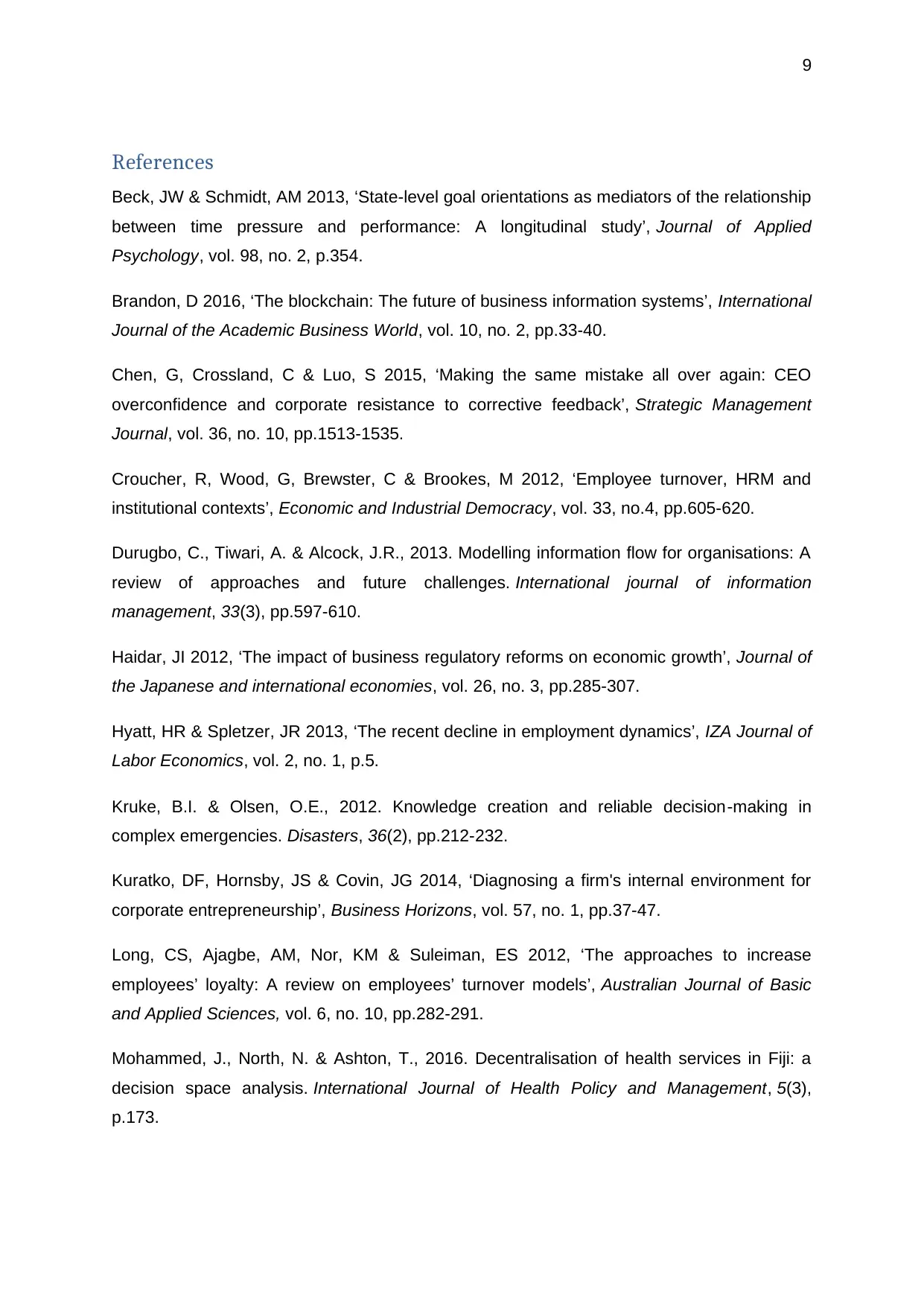
9
References
Beck, JW & Schmidt, AM 2013, ‘State-level goal orientations as mediators of the relationship
between time pressure and performance: A longitudinal study’, Journal of Applied
Psychology, vol. 98, no. 2, p.354.
Brandon, D 2016, ‘The blockchain: The future of business information systems’, International
Journal of the Academic Business World, vol. 10, no. 2, pp.33-40.
Chen, G, Crossland, C & Luo, S 2015, ‘Making the same mistake all over again: CEO
overconfidence and corporate resistance to corrective feedback’, Strategic Management
Journal, vol. 36, no. 10, pp.1513-1535.
Croucher, R, Wood, G, Brewster, C & Brookes, M 2012, ‘Employee turnover, HRM and
institutional contexts’, Economic and Industrial Democracy, vol. 33, no.4, pp.605-620.
Durugbo, C., Tiwari, A. & Alcock, J.R., 2013. Modelling information flow for organisations: A
review of approaches and future challenges. International journal of information
management, 33(3), pp.597-610.
Haidar, JI 2012, ‘The impact of business regulatory reforms on economic growth’, Journal of
the Japanese and international economies, vol. 26, no. 3, pp.285-307.
Hyatt, HR & Spletzer, JR 2013, ‘The recent decline in employment dynamics’, IZA Journal of
Labor Economics, vol. 2, no. 1, p.5.
Kruke, B.I. & Olsen, O.E., 2012. Knowledge creation and reliable decision‐making in
complex emergencies. Disasters, 36(2), pp.212-232.
Kuratko, DF, Hornsby, JS & Covin, JG 2014, ‘Diagnosing a firm's internal environment for
corporate entrepreneurship’, Business Horizons, vol. 57, no. 1, pp.37-47.
Long, CS, Ajagbe, AM, Nor, KM & Suleiman, ES 2012, ‘The approaches to increase
employees’ loyalty: A review on employees’ turnover models’, Australian Journal of Basic
and Applied Sciences, vol. 6, no. 10, pp.282-291.
Mohammed, J., North, N. & Ashton, T., 2016. Decentralisation of health services in Fiji: a
decision space analysis. International Journal of Health Policy and Management, 5(3),
p.173.
References
Beck, JW & Schmidt, AM 2013, ‘State-level goal orientations as mediators of the relationship
between time pressure and performance: A longitudinal study’, Journal of Applied
Psychology, vol. 98, no. 2, p.354.
Brandon, D 2016, ‘The blockchain: The future of business information systems’, International
Journal of the Academic Business World, vol. 10, no. 2, pp.33-40.
Chen, G, Crossland, C & Luo, S 2015, ‘Making the same mistake all over again: CEO
overconfidence and corporate resistance to corrective feedback’, Strategic Management
Journal, vol. 36, no. 10, pp.1513-1535.
Croucher, R, Wood, G, Brewster, C & Brookes, M 2012, ‘Employee turnover, HRM and
institutional contexts’, Economic and Industrial Democracy, vol. 33, no.4, pp.605-620.
Durugbo, C., Tiwari, A. & Alcock, J.R., 2013. Modelling information flow for organisations: A
review of approaches and future challenges. International journal of information
management, 33(3), pp.597-610.
Haidar, JI 2012, ‘The impact of business regulatory reforms on economic growth’, Journal of
the Japanese and international economies, vol. 26, no. 3, pp.285-307.
Hyatt, HR & Spletzer, JR 2013, ‘The recent decline in employment dynamics’, IZA Journal of
Labor Economics, vol. 2, no. 1, p.5.
Kruke, B.I. & Olsen, O.E., 2012. Knowledge creation and reliable decision‐making in
complex emergencies. Disasters, 36(2), pp.212-232.
Kuratko, DF, Hornsby, JS & Covin, JG 2014, ‘Diagnosing a firm's internal environment for
corporate entrepreneurship’, Business Horizons, vol. 57, no. 1, pp.37-47.
Long, CS, Ajagbe, AM, Nor, KM & Suleiman, ES 2012, ‘The approaches to increase
employees’ loyalty: A review on employees’ turnover models’, Australian Journal of Basic
and Applied Sciences, vol. 6, no. 10, pp.282-291.
Mohammed, J., North, N. & Ashton, T., 2016. Decentralisation of health services in Fiji: a
decision space analysis. International Journal of Health Policy and Management, 5(3),
p.173.
Secure Best Marks with AI Grader
Need help grading? Try our AI Grader for instant feedback on your assignments.
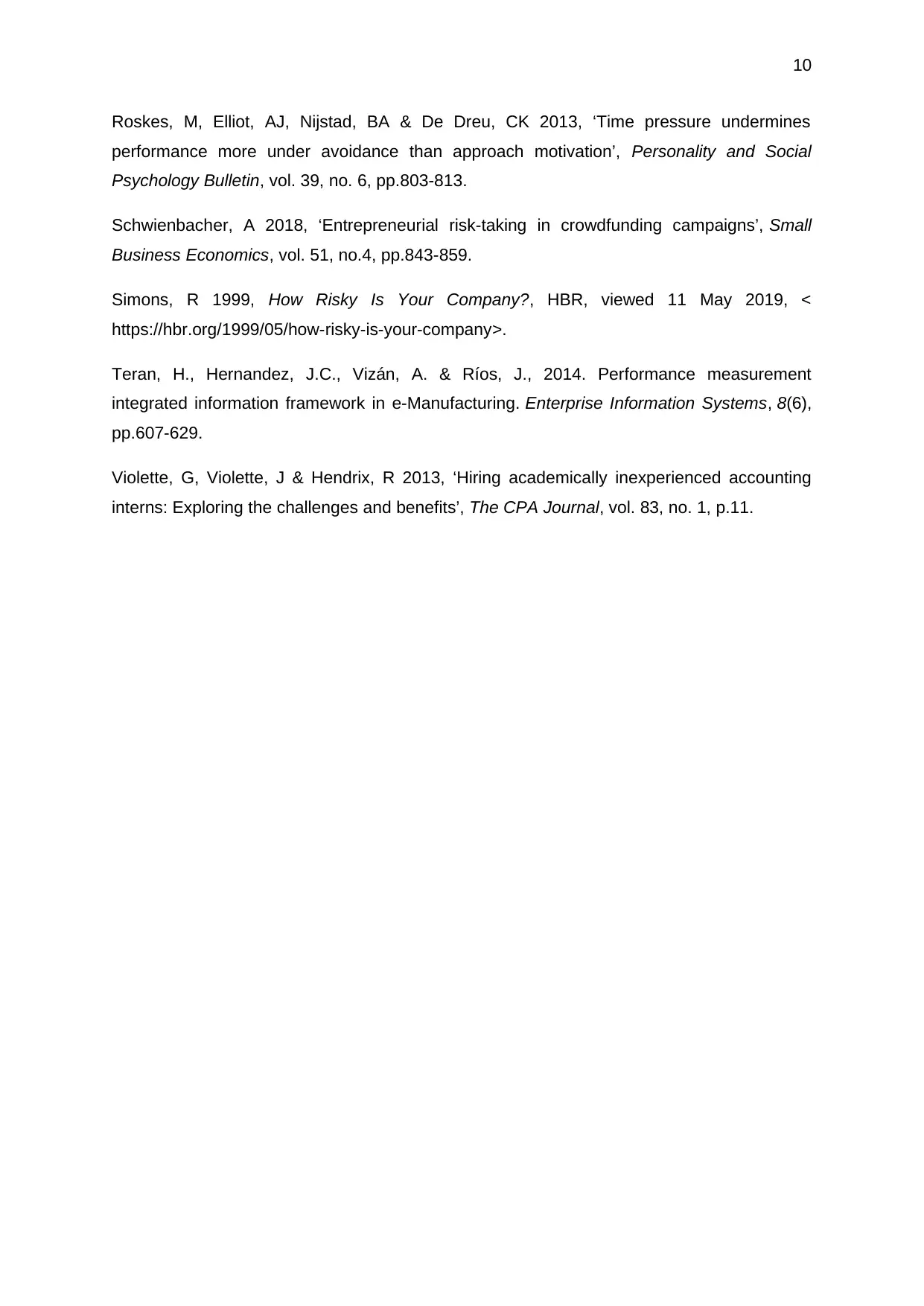
10
Roskes, M, Elliot, AJ, Nijstad, BA & De Dreu, CK 2013, ‘Time pressure undermines
performance more under avoidance than approach motivation’, Personality and Social
Psychology Bulletin, vol. 39, no. 6, pp.803-813.
Schwienbacher, A 2018, ‘Entrepreneurial risk-taking in crowdfunding campaigns’, Small
Business Economics, vol. 51, no.4, pp.843-859.
Simons, R 1999, How Risky Is Your Company?, HBR, viewed 11 May 2019, <
https://hbr.org/1999/05/how-risky-is-your-company>.
Teran, H., Hernandez, J.C., Vizán, A. & Ríos, J., 2014. Performance measurement
integrated information framework in e-Manufacturing. Enterprise Information Systems, 8(6),
pp.607-629.
Violette, G, Violette, J & Hendrix, R 2013, ‘Hiring academically inexperienced accounting
interns: Exploring the challenges and benefits’, The CPA Journal, vol. 83, no. 1, p.11.
Roskes, M, Elliot, AJ, Nijstad, BA & De Dreu, CK 2013, ‘Time pressure undermines
performance more under avoidance than approach motivation’, Personality and Social
Psychology Bulletin, vol. 39, no. 6, pp.803-813.
Schwienbacher, A 2018, ‘Entrepreneurial risk-taking in crowdfunding campaigns’, Small
Business Economics, vol. 51, no.4, pp.843-859.
Simons, R 1999, How Risky Is Your Company?, HBR, viewed 11 May 2019, <
https://hbr.org/1999/05/how-risky-is-your-company>.
Teran, H., Hernandez, J.C., Vizán, A. & Ríos, J., 2014. Performance measurement
integrated information framework in e-Manufacturing. Enterprise Information Systems, 8(6),
pp.607-629.
Violette, G, Violette, J & Hendrix, R 2013, ‘Hiring academically inexperienced accounting
interns: Exploring the challenges and benefits’, The CPA Journal, vol. 83, no. 1, p.11.
1 out of 11
Related Documents
Your All-in-One AI-Powered Toolkit for Academic Success.
+13062052269
info@desklib.com
Available 24*7 on WhatsApp / Email
![[object Object]](/_next/static/media/star-bottom.7253800d.svg)
Unlock your academic potential
© 2024 | Zucol Services PVT LTD | All rights reserved.





